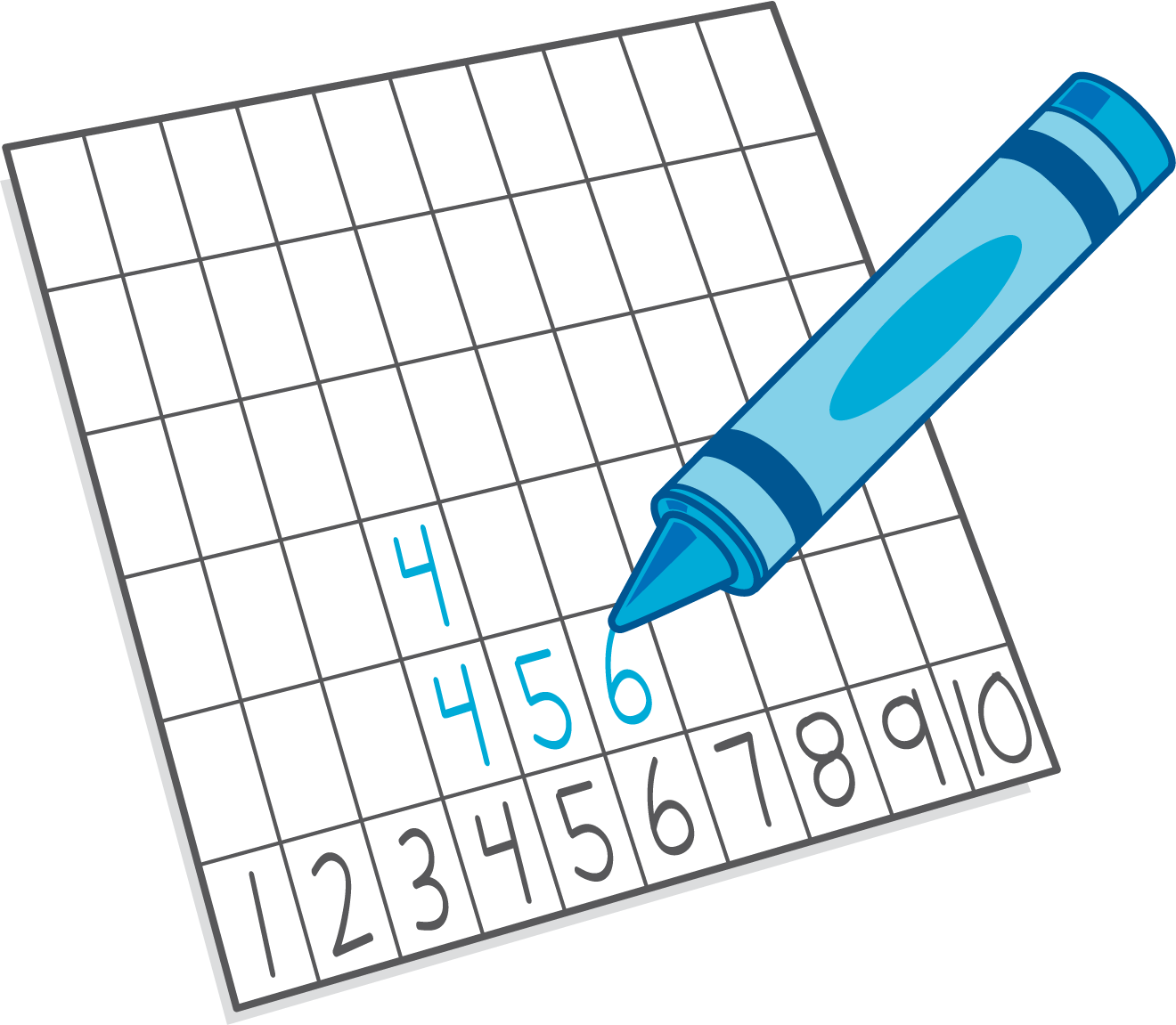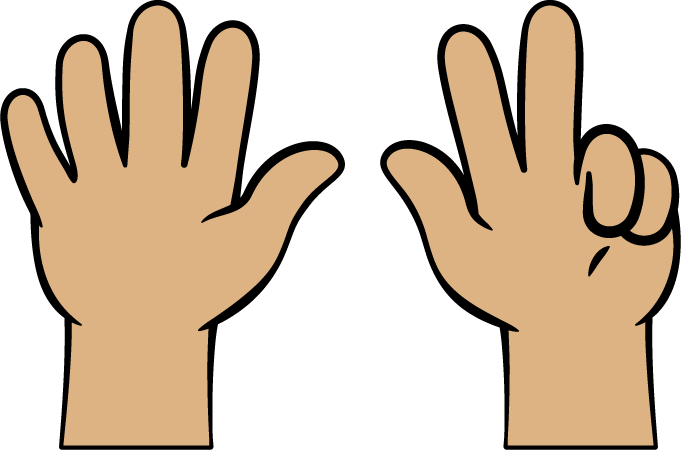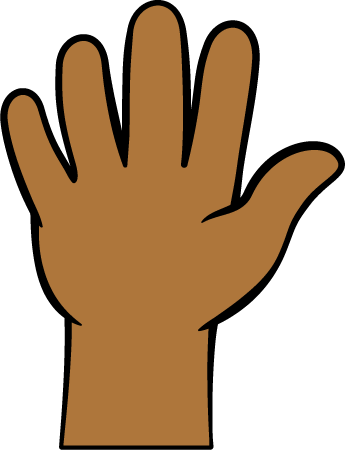Lesson 13
Numbers in Many Ways
Warm-up: How Many Do You See: Different Arrangements of 4 (10 minutes)
Narrative
The purpose of this How Many Do You See is for students to recognize and name groups of images and describe how they see the images. Each image has 4 dots, but they are arranged differently. The number 4 is displayed during the synthesis to give students opportunities to recognize numbers and connect numbers and quantities.
Launch
- Groups of 2
- “How many do you see? How do you see them?”
- Flash the image.
- 30 seconds: quiet think time
Activity
- Display the image.
- “Discuss your thinking with your partner.”
- 1 minute: partner discussion
- Record responses.
- Repeat for each image.
Student Facing
How many do you see?
How do you see them?



Student Response
For access, consult one of our IM Certified Partners.
Activity Synthesis
- Display or write and say “4”.
- ”Each one has 4 dots. Even though they are arranged differently, they are all 4.”
- Display the image of 4 dots in a 5-frame.
- “A 5-frame is one tool that we have been using to arrange and organize objects or pictures. What do you know about this 5-frame?” (There are 5 squares. In this picture, there are 4 dots in the squares. One square is empty.)
Activity 1: Matching Groups of Images and Numbers (10 minutes)
Narrative
The purpose of this activity is for students to match groups of images to numbers. Students count images arranged in circles for the first time, which requires students to keep track of which image they counted first. As students work, monitor for students who:
- mark which image they counted first
- mark each image as they count
Required Materials
Materials to Copy
- Reference Sheet Numbers (1–10) with 5-Frames
Launch
- Groups of 2
- Display the student book.
- “What numbers do you see on this page?”
- “Let’s say each number together.”
- Point to and say each written number on the student page.
- Give students access to the Number Reference Sheet.
- “Draw a line from each number to the group of dots that it matches.”
Activity
- 5 minutes: independent work time
- Monitor for students who have a method for counting images in a circle.
- “Share your work with your partner."
- 2 minutes: partner discussion
Student Facing

Student Response
For access, consult one of our IM Certified Partners.
Advancing Student Thinking
If students count some of the images more than one time or do not count some images, consider asking:
- “Which dots have you counted? How do you know?”
- “What can you do to help you remember which dots you have counted already and which ones you still need to count?”
Activity Synthesis
- Display 8 dots in a circle.
- “How did you figure out how many dots there are?”
- 30 seconds: partner discussion
- Invite previously identified students to share how they counted the dots.
- “What number matches this group of dots?” (8. There are 8 dots.)
- “I can write the number 8 or draw 8 things. They both show 8.”
Activity 2: Different Arrangements, Same Number (15 minutes)
Narrative
The purpose of this activity is for students to match groups of images to numbers. Students match multiple groups of images to the same number. Students start to work with numerical symbols as they learn that the number describing a set of images or objects stays the same no matter how those images or objects or organized (MP7, MP8).
Advances: Speaking
Supports accessibility for: Conceptual Processing, Language
Required Materials
Materials to Gather
Materials to Copy
- Circle Cards
- Sort By Number Mat 1-10
Required Preparation
Launch
- Groups of 2
- Display the number mat and 1 card.
- “What do you notice? What do you wonder?”
- 30 seconds: quiet think time
- “Where do you think I should place this card? Why do you think that?” (There are 7 dots so you should put it by the number 7.)
Activity
- Give each group a set of cards and the sort by number mat.
- “With your partner place each card with the number it matches. Take turns flipping a card and explaining which number the card should go with.”
- 7 minutes: partner work time
Student Response
For access, consult one of our IM Certified Partners.
Activity Synthesis
- “Which cards did you match with the number 5?”
- Share responses. As students share, display the cards that students matched to the number 5.
- “What is the same about all of these cards? What is different about them?” (They all have 5 dots. They look different. Some are in lines and some are in circles.)
- “All of these cards show 5. This number is also 5.”
Activity 3: Centers: Choice Time (20 minutes)
Narrative
The purpose of this activity is for students to choose from activities that offer practice composing, decomposing, and comparing numbers.
Students choose from any stage of previously introduced centers.
- Number Race
- Geoblocks
- Math Fingers
Required Materials
Materials to Gather
Required Preparation
- Gather materials from:
- Number Race, Stage 1
- Geoblocks, Stages 1 and 2
- Math Fingers, Stages 1 and 2
Launch
- “Today we are going to choose from centers we have already learned.”
- Display the center choices in the student book.
- “Think about what you would like to do first.”
- 30 seconds: quiet think time
Activity
- Invite students to work at the center of their choice.
- 8 minutes: center work time
- “Choose what you would like to do next.”
- 8 minutes: center work time
Student Facing
Choose a center.
Number Race

Geoblocks

Math Fingers

Activity Synthesis
- “Which center did you enjoy most today? What did you like about that center?”
Lesson Synthesis
Lesson Synthesis
Write the number 5 and display these 2 cards:


“Mai matched the fingers and the dots in a circle to the number 5. Diego says that the fingers and dots can’t both show 5 because the dots are in a circle and the fingers are in a line. What do you think?” (There are 5 fingers and 5 dots so it doesn’t matter how they are arranged.)
“There are 5 fingers and 5 dots, so they can both go with the number 5. There are many different ways to show numbers. We can use ‘5’ to describe many groups that look different, but all have the same number of things.”
“Let’s practice counting to 20.”
Demonstrate counting to 20. Count to 20 as a class 1–2 times.
Cool-down: Unit 2, Section C Checkpoint (0 minutes)
Cool-Down
For access, consult one of our IM Certified Partners.